
The French and Indian War (1754–1763) was a theater of the Seven Years' War, which pitted the North American colonies of the British Empire against those of the French, each side being supported by various Native American tribes. At the start of the war, the French colonies had a population of roughly 60,000 settlers, compared with 2 million in the British colonies. The outnumbered French particularly depended on their native allies.

Louis-Joseph de Montcalm-Grozon, Marquis de Montcalm de Saint-Veran was a French soldier best known as the commander of the forces in North America during the Seven Years' War.

Fort Carillon, presently known as Fort Ticonderoga, was constructed by Pierre de Rigaud de Vaudreuil, Governor of New France, to protect Lake Champlain from a British invasion. Situated on the lake some 15 miles (24 km) south of Fort Saint Frédéric, it was built to prevent an attack on Canada and slow the advance of the enemy long enough for reinforcements to arrive.

Events from the year 1756 in Canada.
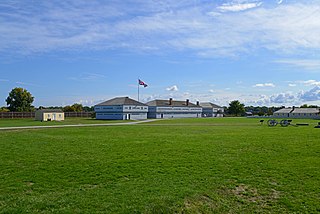
Fort George was a military fortification in Niagara-on-the-Lake, Ontario, Canada. The fort was used by the British Army, the Canadian militia, and the United States Armed Forces for a brief period. The fort was mostly destroyed during the War of 1812. The site of the fort has been a National Historic Site of Canada since 1921, and features a reconstruction of Fort George.
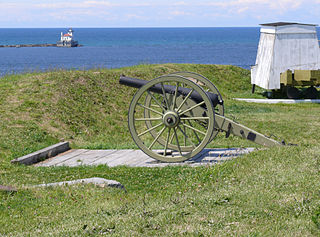
Fort Ontario is an American historic bastion fort situated by the City of Oswego in Oswego County, New York. It is owned by the state of New York and operated as a museum known as Fort Ontario State Historic Site.
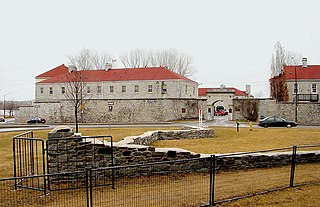
Fort Frontenac was a French trading post and military fort built in July 1673 at the mouth of the Cataraqui River where the St. Lawrence River leaves Lake Ontario, in a location traditionally known as Cataraqui. It is the present-day location of Kingston, Ontario, Canada. The original fort, a crude, wooden palisade structure, was called Fort Cataraqui but was later named for Louis de Buade de Frontenac, Governor of New France who was responsible for building the fort. It was abandoned and razed in 1689, then rebuilt in 1695.
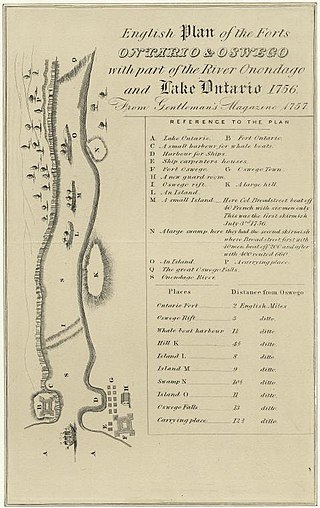
The Battle of Fort Oswego was one in a series of early French victories in the North American theatre of the Seven Years' War won in spite of New France's military vulnerability. During the week of August 10, 1756, a force of regulars and Canadian militia under General Montcalm captured and occupied the British fortifications at Fort Oswego, located at the site of present-day Oswego, New York.
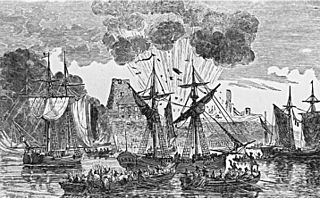
The Battle of Fort Frontenac took place on August 26–28, 1758 during the Seven Years' War between France and Great Britain. The location of the battle was Fort Frontenac, a French fort and trading post which is located at the site of present-day Kingston, Ontario, at the eastern end of Lake Ontario where it drains into the St. Lawrence River.

Fort Loudoun was a British fort located in what is now Monroe County, Tennessee. Constructed from 1756 until 1757 to help garner Cherokee support for the British at the outset of the French and Indian War, the fort was one of the first significant British outposts west of the Appalachian Mountains. The fort was designed by John William Gerard de Brahm, while its construction was supervised by Captain Raymond Demeré; the fort's garrison was commanded by Demeré's brother, Paul Demeré. It was named for the Earl of Loudoun, the commander of British forces in North America at the time.

The siege of Fort William Henry was conducted by a French and Indian force led by Louis-Joseph de Montcalm against the British-held Fort William Henry. This fort, located at the southern end of Lake George, on the frontier between the British Province of New York and the French Province of Canada, was garrisoned by a poorly supported force of British regulars and provincial militia led by Lieutenant Colonel George Monro.
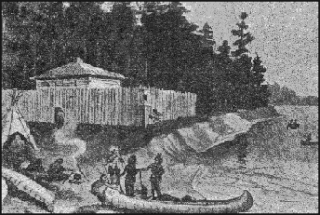
Fort Rouillé was a French trading post located in what is now Toronto, Ontario, Canada. Fort Rouillé was constructed by the French in 1751, building upon the success of a trading post they established in the area a year earlier, known as Fort Toronto. Fort Rouillé was named for Antoine Louis Rouillé, who at the time of its establishment was Secretary of State for the Navy in the administration of King Louis XV of France. It served as a trading post with the local indigenous peoples from the region.

William Burnet was a British civil servant and colonial administrator who served as governor of New York and New Jersey (1720–1728) and Massachusetts and New Hampshire (1728–1729). Born into a position of privilege, Burnet was well-educated, tutored among others by Isaac Newton.

The Oneida Carry was an important link in the main 18th century trade route between the Atlantic seaboard of North America and interior of the continent. From Schenectady, near Albany, New York on the Hudson River, cargo would be carried upstream along the Mohawk River using boats known as bateaux. At the location at modern-day Rome, New York, the cargo and boats would be portaged one to four miles overland to Wood Creek. This portage, which the Haudenosaunee called De-o-Wain-Sta, was known as the Oneida Carry or The Great Carrying Place in English, and as Trow Plat in Dutch. After relaunching into Wood Creek, the bateaux would navigate downstream to Oneida Lake, the Oswego River, and ultimately Lake Ontario at Oswego. Lake Ontario was the gateway to all the Great Lakes stretching another thousand miles inland.
The Battle of Fort Bull was a French attack on the British-held Fort Bull on 27 March 1756, early in the French and Indian War. The fort was built to defend a portion of the waterway connecting Albany, New York to Lake Ontario via the Mohawk River.

Fort George was the name of five forts in what is now the state of New York.

The Fort de La Présentation, a mission fort, was built in 1749 and so named by the French Sulpician priest, Abbé Picquet. It was also sometimes known as Fort La Galette. It was built at the confluence of the Oswegatchie River and the St Lawrence River in present-day New York. The French wanted to strengthen their alliance with the powerful Iroquois, as well as convert them to Catholicism. With increasing tensions with Great Britain, they were concerned about their thinly populated Canadian colony. By 1755 the settlement included 3,000 Iroquois residents loyal to France, in part because of the fur trade, as well as their hostility to encroachment by British colonists in their other territories. By comparison, Montréal had only 4,000 residents.

Fort Halifax is a former British colonial outpost on the banks of the Sebasticook River, just above its mouth at the Kennebec River, in Winslow, Maine. Originally built as a wooden palisaded fort in 1754, during the French and Indian War, only a single blockhouse survives. The oldest blockhouse in the United States, it is preserved as Fort Halifax State Historic Site, and is open to the public in the warmer months. The fort guarded Wabanaki canoe routes that reached to the St. Lawrence and Penobscot Valleys via the Chaudière-Kennebec and Sebasticook-Souadabscook rivers. The blockhouse was declared a National Historic Landmark and added to the National Register of Historic Places in 1968.
The attack on German Flatts was the successful assault on the British colonial settlement of German Flatts, New York by a combined French-Indian force on November 12, 1757 during the French and Indian War. Inhabited by Palatine colonists, the settlement's defenders were defeated by the 300-strong force of attackers, and German Flatts was captured and destroyed. Between 40 and 50 of the colonists were killed, and 150 were captured; in comparison, the French-Indian force only suffered 5 wounded.

Fort Dobbs was an 18th-century fort in the Yadkin–Pee Dee River Basin region of the Province of North Carolina, near what is now Statesville in Iredell County. Used for frontier defense during and after the French and Indian War, the fort was built to protect the American settlers of the western portion of what was then Rowan County, and served as a vital outpost for soldiers, traders, and colonial officials. Fort Dobbs' primary structure was a blockhouse with log walls, surrounded by a shallow ditch, and by 1761, a palisade. It was intended to provide protection from French-allied Native Americans such as the Shawnee and Delaware, and French raids into North Carolina.




















